Turquoise Energy News #207
Covering
Research & Development Activities & Projects of August
2025
(Posted September 12th 2025)
Lawnhill BC Canada - by Craig Carmichael
[Subscribe: email to
CraigXC
at Post dot com ; request subscription]
Main URL TurquoiseEnergy.com Also at craigcarmichael.substack.com
Month
In
"Brief" (Project Summaries etc.)
* Tlell Fall Fair - Electric Caik Motor Refurbishment for Unipolar
Operation Tests - Reflection on Old Battery Experiments: Why was
it 2.6
Volts? - Making Copper Powder for Copper Electrodes - Solar
Powered Car
Charging - New Solar Power System - Tinnitus & "Faraday
Cabin":
Better Grounding Rods
In Passing
(Miscellaneous topics, editorial comments & opinionated rants)
* Scattered Thots
* ESD
- Detailed
Project Reports -
Electric Transport - Electric Hubcap Motor
Systems
* Making the New Electric Hubcap Motor - Caik Motor
refurbishment for "Unipolar" tests
Other "Green" &
Electric
Equipment Projects
* Faraday Cabin Construction - Cutting more styrene foam
insulation
* Haida Gwaii Gardening - Summer
Electricity
Generation
* New Grid Tied System - The usual Latest Daily/Monthly
Solar
Production log et cetera -
Monthly/Annual Summaries, Estimates, Notes
August in Brief
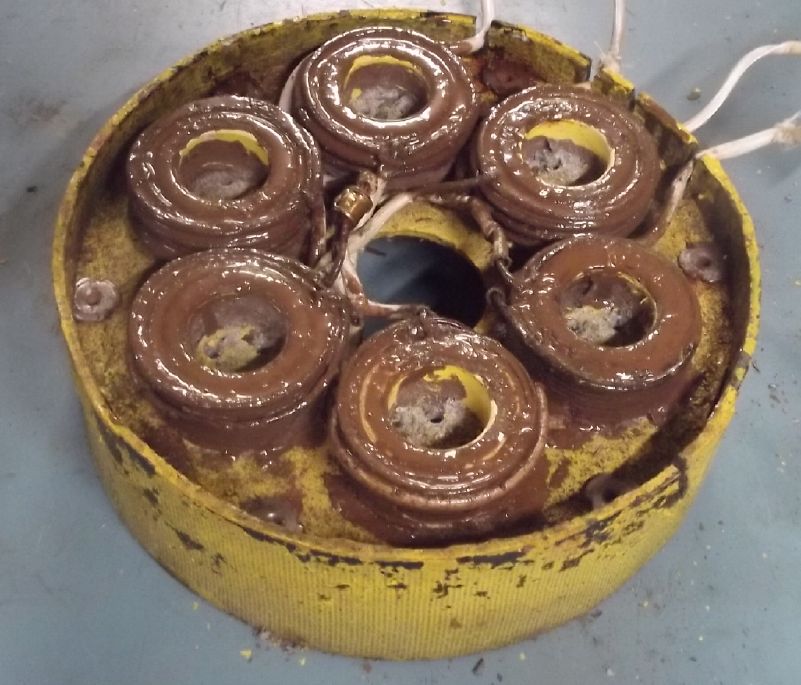 'Touched up" Electric Caik
motor
stator
'Touched up" Electric Caik
motor
stator
- a solidifying coating of epoxy with ilmenite
& separated wire exits plus a wire to the "Y" common point
It was a mostly cloudy, wet, cold summer with only a
few
sunny breaks until the last 1/3 of August and the first week of
September were over two weeks of warm, sunny weather. Lots of things
were behind in the garden and pollinating insects were scarce. The
fine
weather so late was only partial compensation. The single gardening
report is again in the "Other Projects"
section.
A chief preoccupation was writing the How to Make
the
Supercorder Straight Flute textbook, and this will continue
into
September. I'm not sure anyone has ever written a comprehensive book
on
how to make woodwind instruments of any kind, so this may be a
first.
Of course, a lot more may now be available on line and I haven't
been
checking it out. But in addition to much general woodwind instrument
knowledge I gleaned from here and there, this book will also have
the
specific info needed for making this flute, all in one
place.
August started with getting a few "exhibits" ready for
the
Tlell "Fall" Fair on the 2nd.
I brought some plastic
recycling stuff - a mold and some samples, my just harvested
apricots
and josta berries, a coffee tree and some coffee beans my trees
had
grown. (I still haven't used any of the beans! Altogether they
would
still only do one medium roasting.) The tree won first prize in
"house
plants" and the apricots got 2nd in "fruit". Not that there was
much
competition. (If the "fall" fair was later more people would have
more
things ripe!)
On September 6th I pressed the power button on my old
Acer
Aspire One laptop to continue writing, but it didn't boot. Black
screen! I spent the day scouring the web to find a solution, but
none
of the suggested cures brought it to life. Fortunately, I had been
saving my work on a USB memory stick rather than on the laptop's
internal hard drive, to make it easier to copy to another
computer.
That saved the day. (Actually, saved the previous month and more
of
writing! The hard drive is probably recoverable, but I may need to
take
the computer apart and take it out.) Also I tried setting up an
old
Raspberry Pi 2B+, but once it was working it looked like I
couldn't run
my usual HTML editor, Sea Monkey, on it.
All just in case this newsletter wasn't late enough.
Finally I got out the tinnitus causing new laptop that my tinnitus
(and
battery drain) says definitely isn't off even when you shut it
"off"
(what a technicly awesome piece of $hit), and set it up in the
cabin.
With the grounded metal shields over and under, it's at least not
as
bad as working at a computer in the house surrounded by 120 VAC...
or
is it?
12 Coil Unipolar Electric Hubcap Motor
I cast a slab of HDPE plastic for the motor end plate
at
the start of the month, then got the ideas to try driving it with
3-phase unipolar "all norths" drive (with "any old" BLDC motor
controller instead of having to make the special 6-phase "3 norths
and
3 souths" one). Then to try that out on the existing Electric Caik
[outboard] motor first. I would take the boat out on Meyer Lake in
warm
summer weather. That motor needed refurbishing and I didn't get
that
finished either. Okay, can it still be in fall before rains set
in?
Okay, before winter?
Electric Caik Motor Refurbishment for Unipolar Operation Tests
To test the idea of unipolar motor controller
operation
before putting together the "Larger Electric Hubcap" motor (12
coils
instead of 9), I could try the idea on the 6 coil "Electric Caik"
motor
that I had in an outboard. Probably on Meyer Lake. For this I
pulled
the motor out. There was considerable rust on the shaft and
bearing on
the top, and on the bolts holding it together.
And I saw why the cooling was so poor. The air holes
for
cooling in the rotor side (hidden underneath when mounted in the
outboard) were miniature, apparently just the size of the router
bit in
the CNC table. I had neglected to drill them out larger or add
more
holes later.
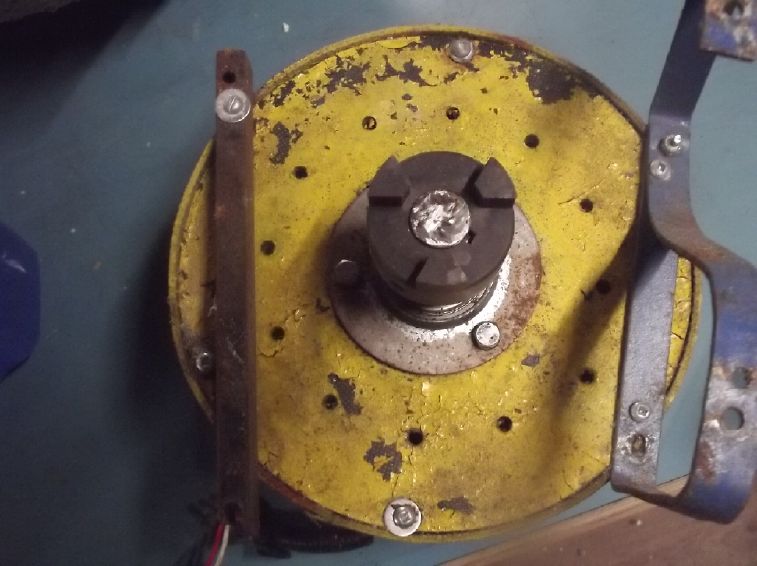
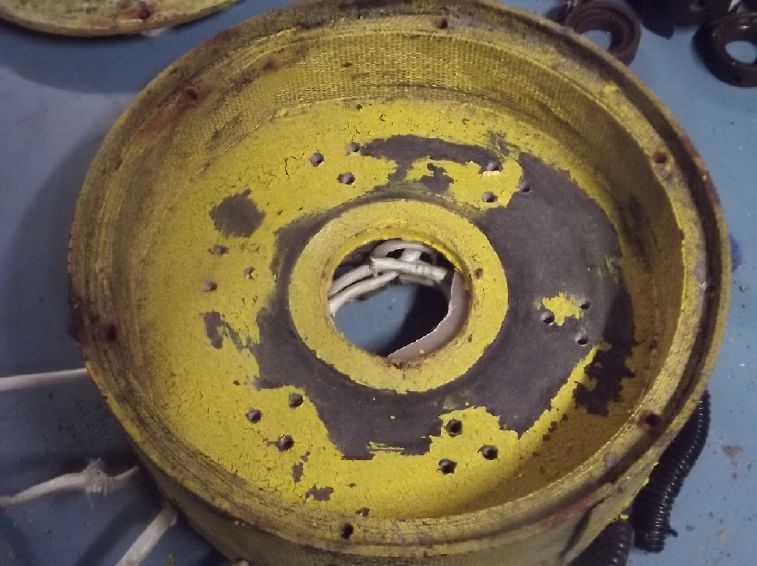 In
the
magnet
compartment,
the
magnets had at some point (long ago, I think) been rubbing on the
separator wall between rotor and stator. But it is one of the
magic
things about axial flux with supermagnets that where magnetic gaps
in
radial flux motors are measured in fractions of a millimeter, they
are
somewhere around 12 mmin mine and others, a distance that prevents
the
coils from gradually demagnetizing the rare earth magnets, and it
even
allows a protective wall between rotor and stator.
In
the
magnet
compartment,
the
magnets had at some point (long ago, I think) been rubbing on the
separator wall between rotor and stator. But it is one of the
magic
things about axial flux with supermagnets that where magnetic gaps
in
radial flux motors are measured in fractions of a millimeter, they
are
somewhere around 12 mmin mine and others, a distance that prevents
the
coils from gradually demagnetizing the rare earth magnets, and it
even
allows a protective wall between rotor and stator.
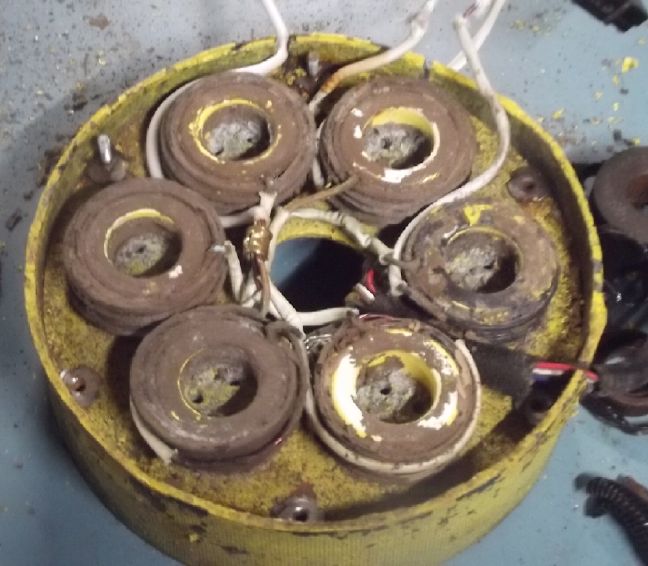 In
the
stator,
some
of the
ilmenite in "Plastidip" had flaked off, and the three wires coming
out
a single slot were fraying, threatening to short out the motor
like the
one on the Sprint had done in 2016. And I had the thought that
perhaps
some on the interconnections inside might be in danger of
vibrating
together and shorting too.
In
the
stator,
some
of the
ilmenite in "Plastidip" had flaked off, and the three wires coming
out
a single slot were fraying, threatening to short out the motor
like the
one on the Sprint had done in 2016. And I had the thought that
perhaps
some on the interconnections inside might be in danger of
vibrating
together and shorting too.
 Having
recently got the idea to simply
add ilmenite to epoxy, I coated at least the tops and down the
outsides
of the coils, and along some of the wires, with it. (I suppose I
could
have pulled the coils out and done all faces. I didn't.)
Having
recently got the idea to simply
add ilmenite to epoxy, I coated at least the tops and down the
outsides
of the coils, and along some of the wires, with it. (I suppose I
could
have pulled the coils out and done all faces. I didn't.)
'Touched
up"
Electric Caik motor
stator
An epoxy with ilmenite
coating
over flaking ilmenite/"Plastidip"
coating,
also to stiffen the wires so
they
don't vibrate.
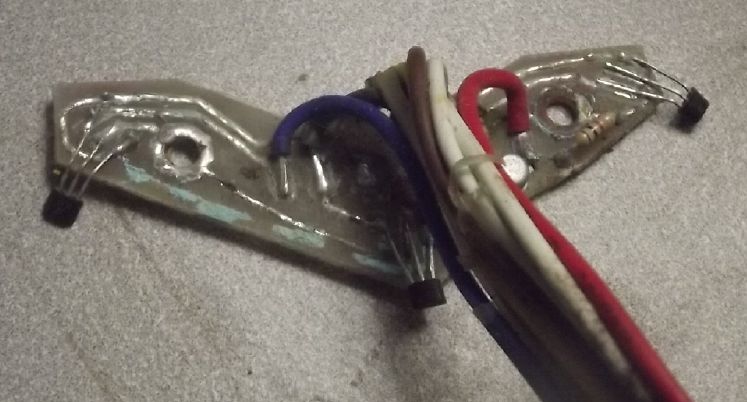 I pulled out the hall
sensors
board to test because it looked corroded.
(and to not get it painted
in
with epoxy!)
I pulled out the hall
sensors
board to test because it looked corroded.
(and to not get it painted
in
with epoxy!)
Somehow that was as far as I got.
Reflection on Old Battery Experiments: Why Were My pH 12 Ni-Zn
Cells
2.6 Volts?
They probably
still
teach in schools that manganese can't
be made to remain in metallic state in aqueous solution! In
2011-2012 I
got manganese to hold its -1.5 V metallic charge at around pH
12-13 by
adding antimony sulfide and zirconium silicate (1%, 3%) as
hydrogen
overvoltage raising additives.
Using nickel oxyhydroxide as the "+" electrode, it
was
charging cells to 2.6 volts. I think I thought the that the nickel
must
be a higher voltage at pH12 than pH14. This is true... but from
+0.5V
to +1+V? That's quite a stretch. Maybe +.7V really?
They would hold that voltage for a while, but mostly
they
seemed to self-discharge quite a bit overnight. Part of that
(which I
didn't understand at the time) would have been hydrogen evolution
at
the Mn negative terminal, because the terminal itself didn't have
the
hydrogen overvoltage raising ingredients. (Zinc bubbling hydrogen
and
turning into zinc hydride at -1.5 V in water would explain why the
zinc
terminals and current collectors corroded as well as the reason
for
self discharge of the "-" electrode. I never determined whether a
graphite/carbon terminal & current collector has a high enough
overvoltage to work without evolving hydrogen. But zinc powder
worked
as a conductivity additive within the electrode, since it was in
with
the Mn and the Sb2S3 and ZrSiO4 overvoltage raising powders. A
solution
might be to paint the terminal post and the back of the current
collector with an insulating coating, probably one sprinkled with
the
overvoltage raising chemicals.)
I seemed to have prevented oxygen evolution from
water (at
least, rapid evolution) with the oxygen overvoltage raising
additives,
but even so, I occasionally think of the above cells and am
puzzled
because that voltage doesn't make sense. Even generously allowing
for
-1.5 V from the metallic Mn at moderate alkaline pH, the nickel
oxyhydroxide should be at most +.7 volts, not +1 volt. That's just
2.2
volts, not very near 2.6.
On my occasional and few discharge tests, it seems to
me
the voltage quickly dropped from 2.6 to 2.3 volts, and then the
discharge proceeded at a more normal pace from there.
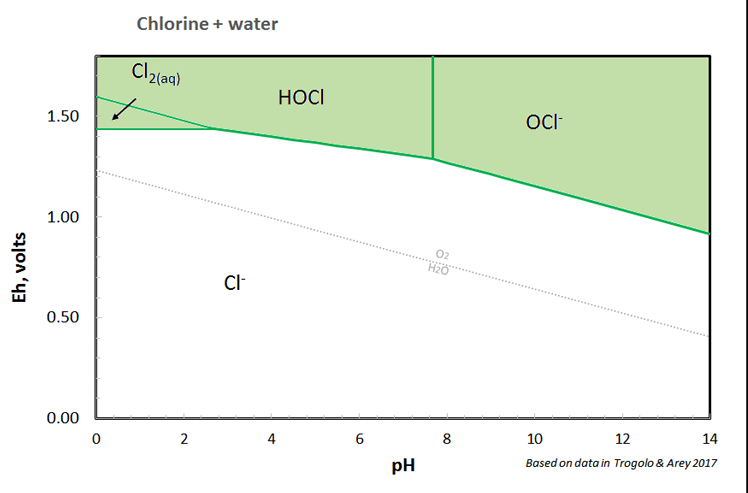 It
has
finally
occurred
to
me to look up a chlorine pourbaix diagram, since I was
using potassium chloride as the electrolyte. Sure enough -- it's a
bit
over +1 volt to oxidize Cl- to ClO- at pH 12). +1 -
-1.5 =
2.5 V. That would explain it! With the K+ that would be potassium
hypochlorite, a form of Bleach for my electrolyte! But it's still
dissolved. (Did I smell any chlorine gas? Would I remember?) There
wouldn't be much of it in contact with the electrode to maintain
that
voltage, so it dropped quickly to 2.3 when I tried a discharge
test.
And surely unless the cell was well sealed, which most of them
weren't,
bleach will pick up O2 from the air and self-discharge. As well as
discharge when ClO- wanders over to the negative 'trode.
'Overnight'
seems a reasonable time frame for the self discharge. And
oxidizing
chlorides probably explains the gradual accumulation of green
colored
gunk on the [graphite] positive terminal on the outside of the
cell -
nickel chloride.
It
has
finally
occurred
to
me to look up a chlorine pourbaix diagram, since I was
using potassium chloride as the electrolyte. Sure enough -- it's a
bit
over +1 volt to oxidize Cl- to ClO- at pH 12). +1 -
-1.5 =
2.5 V. That would explain it! With the K+ that would be potassium
hypochlorite, a form of Bleach for my electrolyte! But it's still
dissolved. (Did I smell any chlorine gas? Would I remember?) There
wouldn't be much of it in contact with the electrode to maintain
that
voltage, so it dropped quickly to 2.3 when I tried a discharge
test.
And surely unless the cell was well sealed, which most of them
weren't,
bleach will pick up O2 from the air and self-discharge. As well as
discharge when ClO- wanders over to the negative 'trode.
'Overnight'
seems a reasonable time frame for the self discharge. And
oxidizing
chlorides probably explains the gradual accumulation of green
colored
gunk on the [graphite] positive terminal on the outside of the
cell -
nickel chloride.
Without exploring further reaction possibilities, I'd say there's
a
longstanding puzzle finally explained! (A nickel manganese oxides
(+) /
manganese (-) cell would probably be about 1.7 to 1.8 volts. It
would
be a simple cell: it wouldn't need to be gelled or have osmium
catalyst.
But the copper hydroxides (+) / zinc (-) cell would
be
superior in energy density (with optimal substance utilization)
and the
cycle life should be indefinite.
To Make Copper Powder for Copper Electrodes
Copper is easy to get. And it's easy to make it into
copper hydroxide or copper chloride. Copper powder seemed like a
different proposition, but I thought copper powder might be a
better
way to start the electrode off than the hydroxides,
notwithstanding
that the hydroxides would form on charging the cell. Matt gave me
some
copper powder for experiments, but what about actual battery
production? To make powder I had visions of vacuum systems with
heat,
'sputtering targets' and compressed air to melt the copper and
blow it
to gritty powder - not exactly DIY processes, and also doubtless
much
less fine than nano powder.
[28th] Youtube suggested a short video on pouring molten copper
into
water. It didn't even show the final product, just a guy pouring
copper
into a barrel of water! But that got me started. I found another
one
but the product wasn't powder at all. More like chunks of 'coral'.
(What, you're not surprised either?)
Then I tried going for the obvious search: "make
copper
powder". To my surprise a simple chemical procedure does it!
Starting
from a copper chloride solution (his was left over from PCB
making),
hydrochloric acid was added. Then four large steel nails. The
nails
quickly turned black. (Ferric chloride?) But then, on top of that,
pure
copper fuzz started to form on the nails! It kept going until the
solution was clear and there was a heavy coating of copper fuzz on
the
four nails. He rubbed it off the nails, rinsed and dried it. In
the
comments it was said to be fine flakes. Just what I wanted!
Hydrochloric acid plus hydrogen peroxide will turn
copper
into copper chloride. Ferric chloride will also turn copper into
copper
chloride. Hydrochloric acid turns iron into ferric chloride (I
presume), and that plus hydrochloric acid somehow (iron having a
higher
reaction voltage than copper and no passivation layer forming)
turns
copper chloride back into copper. Presumably it also makes
dissolved
ferrous chloride, which can be rinsed out. So there's a pretty
simple
way to turn solid copper into fine powder-flakes of copper!
Of course copper has many soluble ions. I expect it
to
charge even to valence III, probably as "cuprate ions" Cu(OH)3-,
similar to the "zincate ions" except at opposite points of charge
and
discharge, making the cell to be about 1.2 volts with very high
amp-hours. And I expect to use the same techniques to keep these
ions
from migrating out of the electrode. The OH- ions will transfer
between
electrodes on charge and discharge, coupling with the copper or
the
zinc.
On the 13th I went to Meyer lake and sun tanned until a
couple
of horseflies came along. I jumped up and put my shirt on. I charged
the car half way from off-grid solar, 6 KWH worth while the sun was
out. The next day was cold, windy and poured rain. So much for
summer?
But the 21st was improved and the 22nd to early
September
were sunny and warm - summer was back! (or was it "finally here"?)
but
now we're headed for fall.
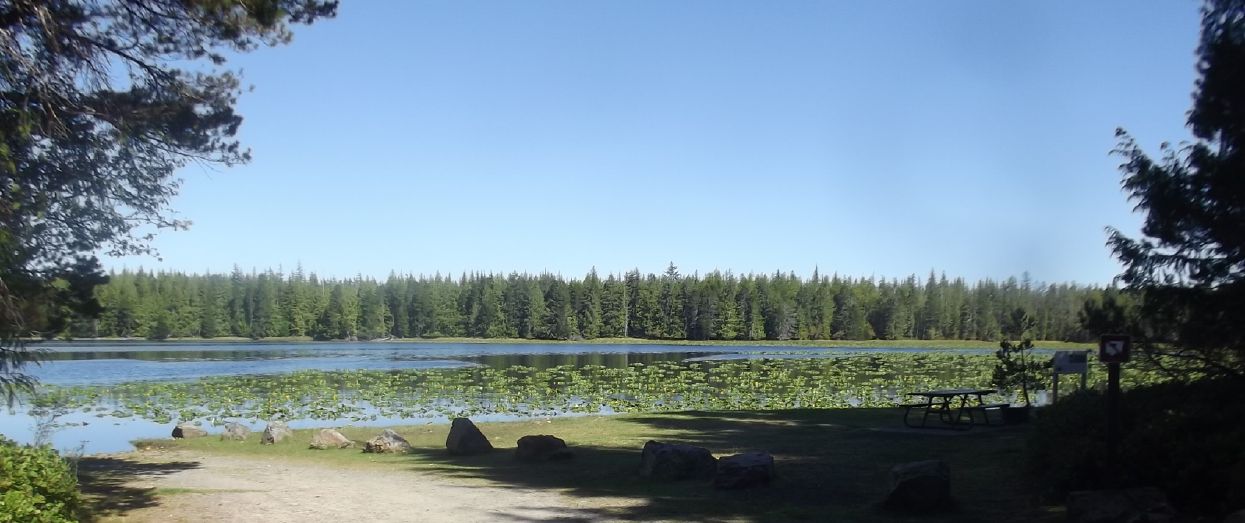 Meyer Lake picnic area
Meyer Lake picnic area
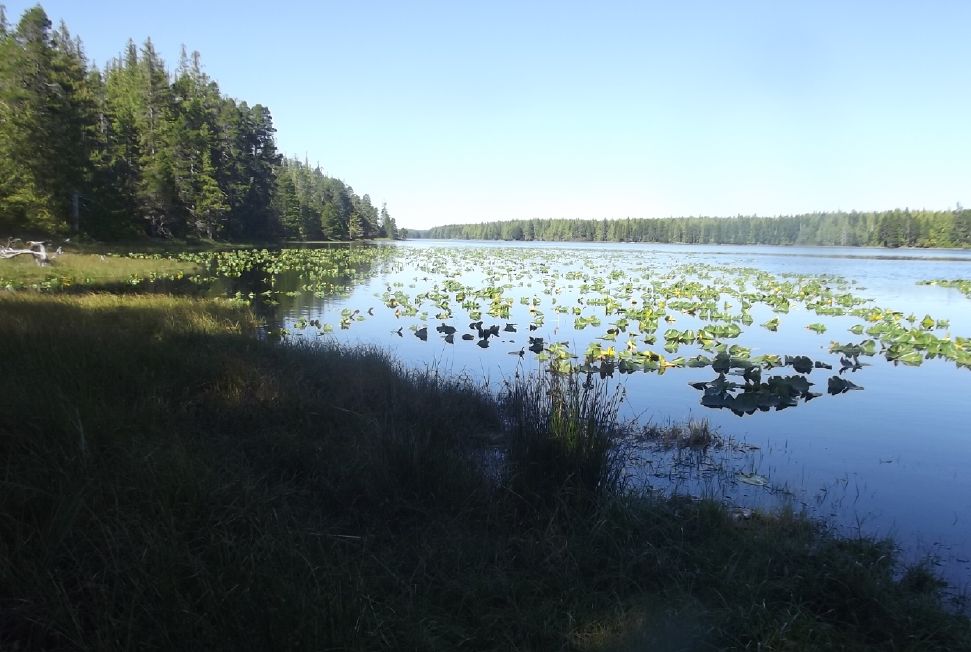
Looking west from the boat ramp.
This is only the southern tip of the lake - at the
"far end" it turns north and goes on for many miles.
Solar Car Charging
On sunny days I charged the Nissan Leaf at 1.5 KW
"slowest" rate from the off-grid solar. For a typical example on
the
27th I drove to town. The car was at 60% when I got back and I
recharged from solar - a 6-1/2 hour almost 10 KWH charge session.
And
like I say, autumn was on its way. Although the sun was bright,
the
system was only bringing in 1200 watts while the car charger was
using
1500. I looked outside. Sure enough, the shadows from the three
spruce
trees to the south were across the house garden and up the wall
shading
the three solar panels there. (September they'll start shading the
whole roof.) Later the shadows passed and the house battery
charging
started catching up with the car's discharging. Still later of
course
the sun went behind the trees to the west and the car charge came
mainly from house battery discharge. But by then the car was
mostly
charged. Score:
- from solar: +6 KWH
- 24 KWH car battery: +9.75 KWH
- 10 KWH house battery: -3.75 KWH to be made up the next day.
New Solar Power System
 [22nd]
The
electrician, Adam, finally came and we connected the solar
inverters to the circuit breaker panel via the BC Hydro required
outdoor shutoff box. All the wiring in metal conduit. The worst
'renovation' thing was removing a small section of wallboard for
the
conduit connection. Luckily the breaker panel, tho on an inside
wall,
wasn't far in from the outside wall, and the wall space, despite
its
proximity to the breaker box, wasn't already full of wiring. (one
doorbell wire.) [28th] Adam brought the "lamacoid" labels and
pasted
them on, and he added a copper ground wire apparently required by
code
inside the grounded metal pipe.
[22nd]
The
electrician, Adam, finally came and we connected the solar
inverters to the circuit breaker panel via the BC Hydro required
outdoor shutoff box. All the wiring in metal conduit. The worst
'renovation' thing was removing a small section of wallboard for
the
conduit connection. Luckily the breaker panel, tho on an inside
wall,
wasn't far in from the outside wall, and the wall space, despite
its
proximity to the breaker box, wasn't already full of wiring. (one
doorbell wire.) [28th] Adam brought the "lamacoid" labels and
pasted
them on, and he added a copper ground wire apparently required by
code
inside the grounded metal pipe.
Tinnitus & "Faraday Cabin":
Better Grounding Rods
[30th] Once again had I started not getting the tinnitus relief I
expected by morning from sleeping in the cabin. as if it just
wasn't
working any more. Everything was turned off at night, what could
it be?
I finally realized: My "ground rods" were pretty skinny pieces of
copper pipe. I could only pound them into the ground 8-18 inches
or so
before they started to bend. Now that we were (at last, at last!)
having dry, sunny summer weather for ten days, the ground under
the
eaves was probably drying out to that depth and so my pipe rods
probably weren't making good electrical contact with the earth, so
the
cabin wasn't "Faradaying" and EMF from the 14,400 volt power line
was
getting through. I went to the refuse station (What luck, it's
open
today and I have some old flashing to take and toss on the metal
pile.)
Wow! I found three 12 foot bars of steel, 1/8 x 3/4 inches,
seemingly
as new. They were on the ground separate, a few feet from the
pile. The
donor must have thought someone might want them. (And we're so
lucky
Ralph sets aside anything that looks useful for anyone who can use
it
to take. I remember in Victoria (BC) the landfill treated
everything
people dropped off as their personal treasure. Everything had to
be
added to the mountain. The triangle of waste management is
"reduce,
reuse, recycle" but those in charge didn't allow anyone to reuse
anything. Those in charge of the waste break the triangle
themselves!)
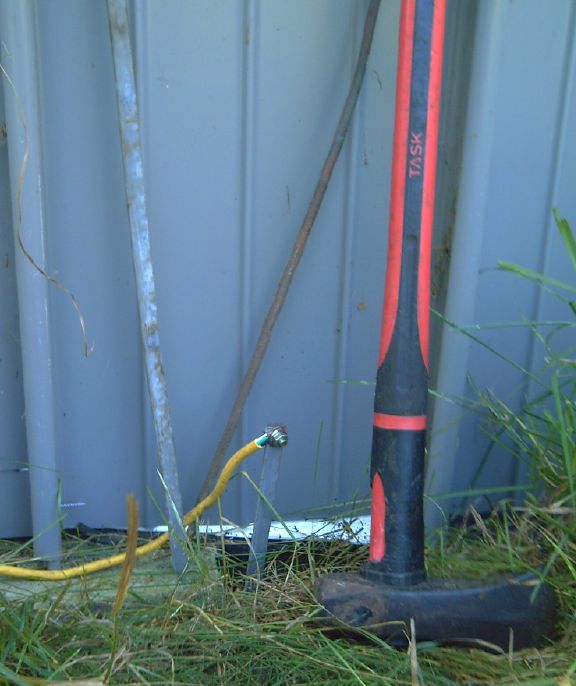 [31st]
I
cut
two
five
foot
long bars and sharpened one end. I drilled and
threaded the other end for a 5/16 inch bolt to attach the wire. I
started in the middle of the long walls, disconnecting the wires
and
pulling up the copper pipes. The bars didn't fold up when I
pounded
them to over 4 feet deep - much better! Later I cut two more for
the
corner grounds of the cabin later.
[31st]
I
cut
two
five
foot
long bars and sharpened one end. I drilled and
threaded the other end for a 5/16 inch bolt to attach the wire. I
started in the middle of the long walls, disconnecting the wires
and
pulling up the copper pipes. The bars didn't fold up when I
pounded
them to over 4 feet deep - much better! Later I cut two more for
the
corner grounds of the cabin later.
[Sept. 1st] Overnight it seemed a little better. Then I thought to
test
with a meter. If I disconnected the new ground rods, only at the
end of
the cabin nearest the power line was it a little over 20 mV.
Reconnected it was under 20 mV everywhere, and definitely lower
than
without them everywhere - 5 or 6 mV in my bedroom versus 12 or 15
mV.
All those figures are way lower than anywhere else except by going
back
in the forest well away from electrical sources. Just how low does
one
really need to get it to eliminate tinnitus?
In a couple of days I had the rest of the grounding
rods
made and installed at the corners too, total six.
And what else is there? I can't measure UHF/WiFi. An
RF
meter went wild in front of my solar charge controllers - in
addition
to ultrasonic sound, 100 KHz switching is an LF radio frequency.
They
(along with wall power adapters and DC to DC power adapters) are
probably putting out both ultrasonic sound and electrical noise.
For now I turn off the charge controller when I'm in
the
cabin, especially for the night. And I keep the new laptop, which
obviously is never "off" whatever it claims, in a grounded metal
breadbox at the far end of the cabin when I'm not using it, and in
the
metal "sandwich" with external keyboard and mouse when I am. I
have to
leave the screen sticking up because Linux doesn't seem to want to
drive the HDMI port external screen. ("Solutions" I see on line
look
complex. They confuse me - the guy who once wrote the world's
first
"RPG" game, "Viking Raider" for the Commodore 64 (1984) can't
figure it
out.)
In
Passing
(Miscellaneous topics, editorial comments & opinionated rants)
Scattered
Thots
* In a meeting where Donald Trump of USA expressed concern about
stifling of freedom of speech in the UK, UK prime minister Kier
Starmer
proudly declared "Britain has had freedom of speech for
centuries."
What level of disconnect from reality does that assertion require
when
his own government, under him, has passed laws (the so-called
"online
safety act") which are arresting people in droves because of "hate
speech" posts they've made on social media platforms expressing
opinions that "might cause someone offense" or that are critical
of
government or its policies? [What constitutes "hate speech" was
not
defined in the law - so they can arrest and charge anyone for
anything.] In the UK, as is the trend across Europe, it is
presently more dangerous to liberty to post an opinion
on social media than to commit an actual violent crime.
* Before the invention of the birth control pill in the 1960's,
families came unbidden, wanted or not. In the decades before good
birth control, the
reduction of wars and multiple improvements in living conditions
providing lengthening lifespans set the world up for rapid and
serious
overpopulation. When I was born in 1955, my 29 year old mother was
considered unusually old to be having her first child and the
doctors
were concerned.
I think it's very unfortunate that only the more
advanced
nations adopted birth control at first. Uneducated Africans
thought the
whole idea was voodoo. As the whole world becomes more educated, a
few
lagging nations are only now starting to really reduce their
birthrates. World population has risen from 2.75 billion when I
was
born to over 8 billion today. which has led to ever dropping
standards
of living all over the ever more interconnected world. The
birthrates
in the more advanced countries have continued to drop with living
standards, to the point where whole races are being drasticly
reduced
in numbers or even replaced by the more prolific in just a few
generations. (Who wants to bring children into a deteriorating
economy
with employment and income ever uncertain? Who can afford to? With
good
birth control available, dropping prosperity = no kids.)
The good news of course is that as us older folks die
off,
with so few younger ones, the standards of living will probably
rise
sharply in the coming century or two, and they will stay high
because
only wanted children will be born to prosperous parents, and the
world's population will stabilize at perhaps between 2.5 and 3
billion
people.
In the meantime, we've polluted the planet and used
up the
resources. Species are dying out at an unprecedented rate. For now
quality of life is still deteriorating and I still think a great
crisis
is just ahead of us before things start to get better.
I'm not sure where the graph below is from. (USA?)
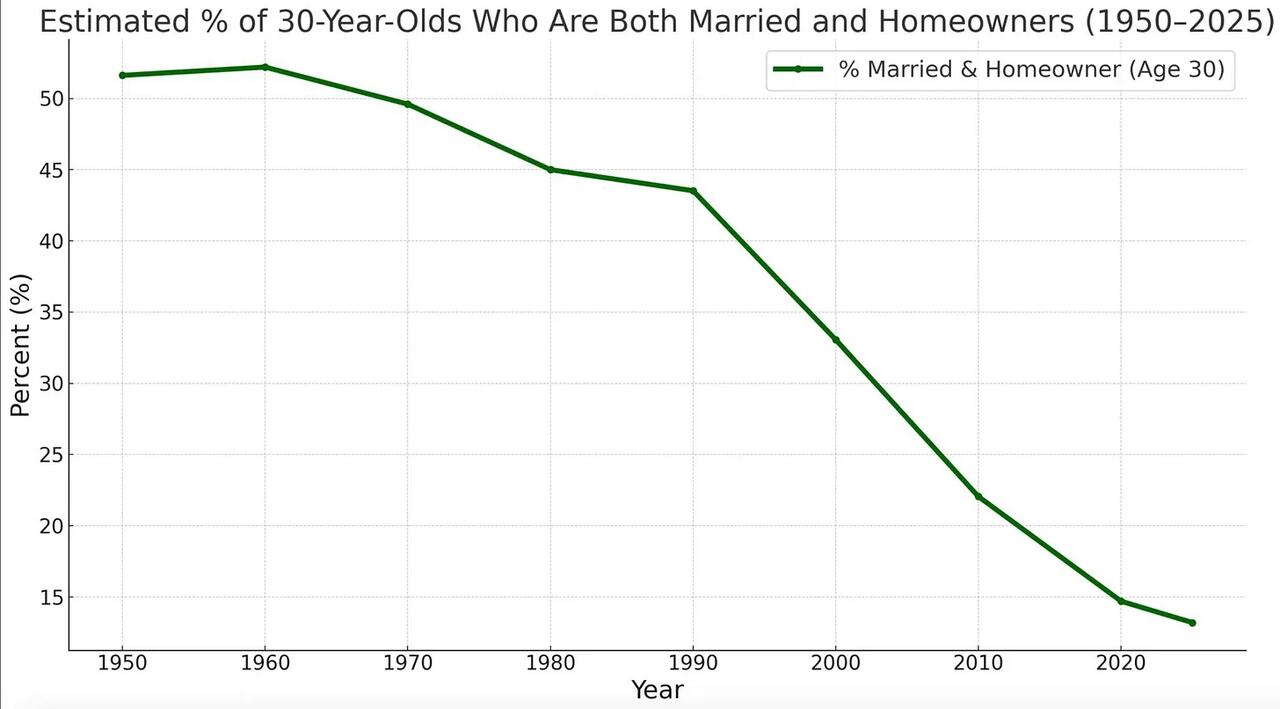
And what is the percentage of these who also have
kids?
ESD
(Eccentric Silliness Department)
* Grammer: A scale for weighing small quantities.
* Apahelion: The maximum height of apathy.
"in
depth
reports" for each project are below. I hope they may be useful to
anyone who wants to get into a similar project, to glean ideas for
how
something might be done, as well as things that might have been
tried,
or just thought of and not tried... and even of how not to do
something
- why it didn't work or proved impractical. Sometimes they set out
inventive thoughts almost as they occur - and are the actual
organization and elaboration in writing of those thoughts. They
are
thus partly a diary and are not extensively proof-read for
literary
perfection, consistency, completeness and elimination of
duplications
before publication. I hope they may add to the body of wisdom for
other
researchers and developers to help them find more productive paths
and
avoid potential pitfalls and dead ends.
Electric Transport
12 Coil Electric Hubcap Motor
The HDPE Stator End Plate
 [9th]
I
re-melted
the
HDPE
slab in the
plastic oven at 186 degrees instead of 180, with ~80 pounds of
weights
instead of 40 on top of the mold. It still didn't flow well, and
it was
almost an inch thick in one corner and just 5/8 in the opposite
one.
But it looked like I could cut out a solid piece big enough for
the
motor end plate. I would have to route it flat as well as route
out the
required contours to mount the coils.
[9th]
I
re-melted
the
HDPE
slab in the
plastic oven at 186 degrees instead of 180, with ~80 pounds of
weights
instead of 40 on top of the mold. It still didn't flow well, and
it was
almost an inch thick in one corner and just 5/8 in the opposite
one.
But it looked like I could cut out a solid piece big enough for
the
motor end plate. I would have to route it flat as well as route
out the
required contours to mount the coils.
The G-Code I wrote for the router worked fine in
plywood.
But given my recent experiences with trying to route HDPE on the
CNC
table router, I think I should use a 1/2 inch router bit instead
of 1/4
inch or 6 mm. I'm guessing the small ones don't seem to throw the
chips
clear, and instead they re-melt in a half-fused mess right behind
where
the router is traveling. (And yet I don't remember this happening
with
the old router table & router in Victoria. But I usually (or
always?) used bigger bits to do the job faster.) This means
re-working
all the G-Code in the spreadsheet for the new diameter bit -
Ug!
(This is one of those times when I wish I had done it all in a CAD
program that would generate the G-Code for me.)
Motor Controller Testing Idea
To run as unipolar with single polarity 3-phase
outputs,
it occurred to me that my present Kelly BLDC controller (KBL36301)
even
with a busted low drive on one phase, could probably be used by
using
the three high side drives, all good. (Assuming I didn't bust it
completely in 2016 when I was trying to repair it.) Furthermore,
it
might run an existing motor, say my "Electric Caik" outboard. That
could be tested, even on the water. Or I could use the homemade
motor
controller - which also has a blown low side drive IIRC. (and I
could
fix that one.)
[13th] I went to Meyer lake for a little sun tan. For me it was
too
cold for a swim - just a wade. There were fat tadpoles growing
legs and
turning into frogs or toads in the water at the boat launch ramp.
Say,
that could be a great place to try out the electric outboard with
that
controller! I would have to re-configure the coil wiring -- and
definitely add a cooling fan while I was at it. I recall the motor
getting hot enough to smell like hot epoxy last I ran it in 2018
or
2019, even running at just 30 amps (30A * 24V = 1 HP), because it
just
didn't have much of any cooling. I hope it could do 60 amps (2 HP)
continuous.
It would be great to confirm that my idea would work.
I
unbolted the motor from the outboard. Rusty shaft and bearings!
 [15th] I looked at the motor to
see where I might add in a small cooling fan. Wait! How on Earth
are
the spinning magnets, acting as a centrifugal fan, supposed to
flow
cooling air through those tiny little air outlet holes? No wonder
it
doesn't cool well! Before going to the trouble of putting in a
cooling
fan, I think I should just try making the holes bigger and more
numerous. So the jobs on the motor are to drill holes and to bring
the
coil common centers out through a wire. Not so much to do! The set
screw on the bearing tightener wouldn't come out so I sprayed some
WD40
on all the rusty looking parts.
[15th] I looked at the motor to
see where I might add in a small cooling fan. Wait! How on Earth
are
the spinning magnets, acting as a centrifugal fan, supposed to
flow
cooling air through those tiny little air outlet holes? No wonder
it
doesn't cool well! Before going to the trouble of putting in a
cooling
fan, I think I should just try making the holes bigger and more
numerous. So the jobs on the motor are to drill holes and to bring
the
coil common centers out through a wire. Not so much to do! The set
screw on the bearing tightener wouldn't come out so I sprayed some
WD40
on all the rusty looking parts.
[17th] I got the set screw loose, took the ends off the motor and
pulled the rotor out. Funny how much you forget - I thought the
rotor
was still stuck, but it was only being held magneticly. Also, to
open
the stator and get at the wiring I would have to undo the 18 nylon
bolts holding the coils on and holding it together. Hmm, power
connections... the three magnet wires came out together with just
their
own enamel and thin sleeving for insulation (to a triple Anderson
70A
APP connector) - the same arrangement that, with electromagnetic
vibration, had shorted the motor in the car and burned out a phase
(low
side) in the Kelly controller in 2016. I would have to improve
that
while I had it apart!
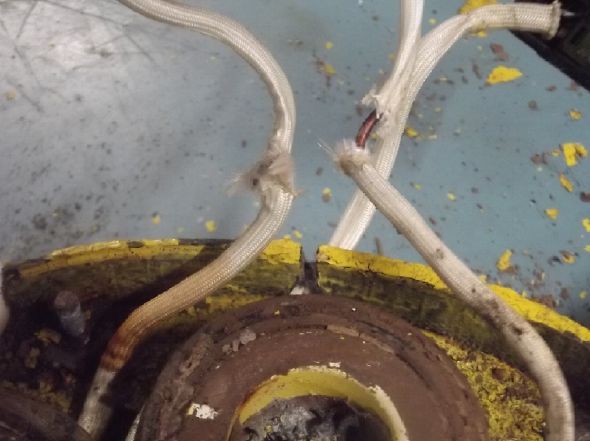 [18th]
Sure
enough
-
the
sleeving has frayed
off. How long would it have run before the thin enamel rubbed
through
and shorted?
[18th]
Sure
enough
-
the
sleeving has frayed
off. How long would it have run before the thin enamel rubbed
through
and shorted?
[19th] In my first motors I made coils with 60 turns of #14 wire.
The
coils of each phase were in parallel. Since two phases were in
series
at any given time, that's 120 turns across the 36 volts. That
seemed to
work quite well. Then I made the 9 coils with 20 or 21 turns of
#11
wire and put the three coils of each phase in series instead of in
parallel. With two phases again in series, that's 120 to 126 turns
of
wire across the 36 volts. The Electric Caik motors were two coils
per
phase instead of three and 24 volts instead of 36.
Now for the new 12 coils unipolar motor I've wound
each
coil with 27 turns. There are four coils (in series) per phase,
but one
side of each phase is grounded instead of them being two in series
via
the more common "Y" configuration, so that makes 108 turns across
36
volts. The currents will ramp up a little faster. 27 turns makes 3
full
layers of wire on the coil cores. I didn't want to expand it to
four
layers in case that might leave too little space (or even overlap)
between coils. I recall making the overall motor diameter as small
as I
dared, which will put the coils quite close together.
 One day in here I drilled the
ventilation holes bigger in the rotor end cover plate.
One day in here I drilled the
ventilation holes bigger in the rotor end cover plate.
 [22nd] I removed the hall
sensors board as it looked corroded, and anyway I didn't want to
paint
it in when I touched up the coils & connecting wires. I
decided I
should make a 3 LED "breakout" board for between the motor
controller
and motor, to show which magnet sensors were on and off and
disclose
any sensor faults or wrong patterns as the motor was turned.
[22nd] I removed the hall
sensors board as it looked corroded, and anyway I didn't want to
paint
it in when I touched up the coils & connecting wires. I
decided I
should make a 3 LED "breakout" board for between the motor
controller
and motor, to show which magnet sensors were on and off and
disclose
any sensor faults or wrong patterns as the motor was turned.
 [25th]
I
mixed
28
g
of epoxy with ilmenite
and painted around the inside of the motor, going over the
windings of the coils (for the ilmenite - some had flaked off) and
their connecting wires (to stiffen them so they wouldn't vibrate
and
rub and eventually short out).
[25th]
I
mixed
28
g
of epoxy with ilmenite
and painted around the inside of the motor, going over the
windings of the coils (for the ilmenite - some had flaked off) and
their connecting wires (to stiffen them so they wouldn't vibrate
and
rub and eventually short out).
Now it's waiting for me to check out the hall sensors
board before reassembly.
Other
"Green" & Electric Equipment Projects
Faraday Cabin Construction
 [12th]
I finally got around to clearing off the "hot wire table saw" to
cut
foam (or is it a "hot wire foam mill"?). I now had the huge chunk
from
the beach which I had thought had a plastic barrel for a center (I
thought I heard water sloshing around inside it), and a smaller
one I
got from the recycling center - Craig phoned me to let me know it
was
there.
[12th]
I finally got around to clearing off the "hot wire table saw" to
cut
foam (or is it a "hot wire foam mill"?). I now had the huge chunk
from
the beach which I had thought had a plastic barrel for a center (I
thought I heard water sloshing around inside it), and a smaller
one I
got from the recycling center - Craig phoned me to let me know it
was
there.
I cut the smaller one without issue except that at 19
volts it went somewhat more slowly than necessary. Sticking a thin
round file deep into the large one showed it was in fact nothing
but
foam. No plastic barrel center after all! It was so wide toward
the
center that I had to use bigger C-clamps and put about 4 inches of
blocks in to increase the effective "width of the table" and hence
the
length of the hot wire. There was almost no wire not inside the
foam.
If it had been any wider I'd have had to come up with some new
arrangement. With the longer wire I finally got out a DC power
monitor
and a screwdriver and set the voltage to 24 volts to make it
hotter and
speed things up. (It dropped to 22 volts under load, drawing 3.33
amps.)
I pulled the hot wire out from one of its end bolts
once,
which was much better than all the breaks cutting the foam piece
infused with mussel shells and toredo worm castings that just
wouldn't
melt.
I cut several nice big 5 inch thick slabs. When the
edges
are trimmed with the large handheld hot wire cutter, I should have
enough foam insulation to do the next ceiling section top and
bottom,
using some fiberglass to fill in the middle areas.
Also it's really nice to finally get these big blobs
out
of the garage! The Chevy Sprint has been sitting out on the lawn
since
March when the solar power system arrived on a big palette, and
the
garage still needs more de-cluttering.
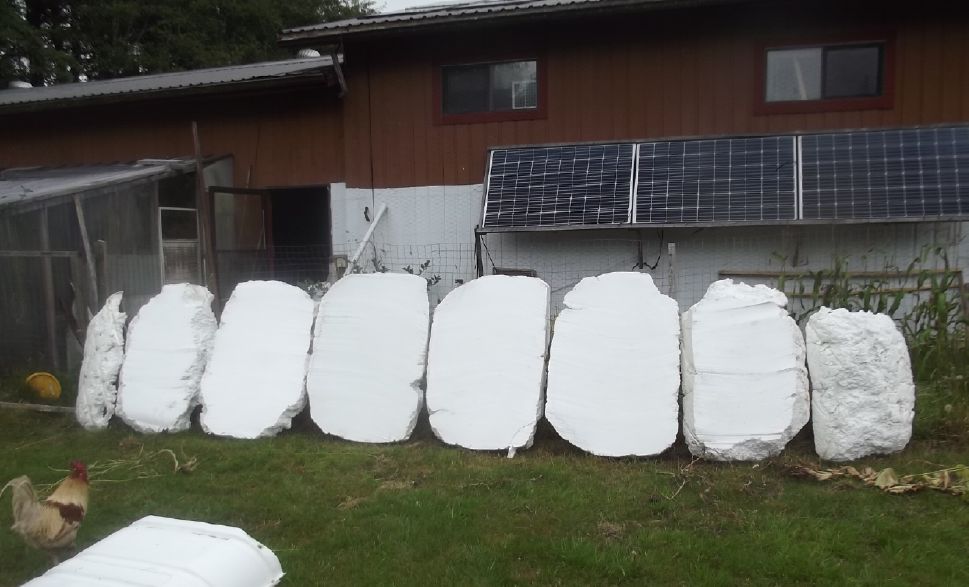 The cut chunks.
The cut chunks.
Foto-bomber at left wants to start pecking at them.
No, it's not good for you! Go away!
I remembered to set the DC to DC power adapter back
to 19
volts again before I took it back out to the cabin to power my old
19
volt laptop computer so it wouldn't blow up when I went to write
this.
(It quit working later anyway.)
Haida Gwaii Gardening - Summer
August was when the
gardens
finally got growing after a cold, windy, rainy spring most days
until
mid July. Somehow I did find enough decent days earlier to plant
all my
plots. There seemed to be a big shortage of pollinating insects
this
year, again probably because of the weather. The blooming
sunflowers
usually have bugs crawling all over them. This year I'd see one or
two.
I suspect they'll have lots of empty seed shells.
It was so cold that the April buds on my walnut trees
all
died. I feared the trees were dead. In July I saw a bud or two on
the
Carpathian English walnut. Not totally dead?!? I belatedly put
plastic
bags over them both to keep them warmer in the wind.
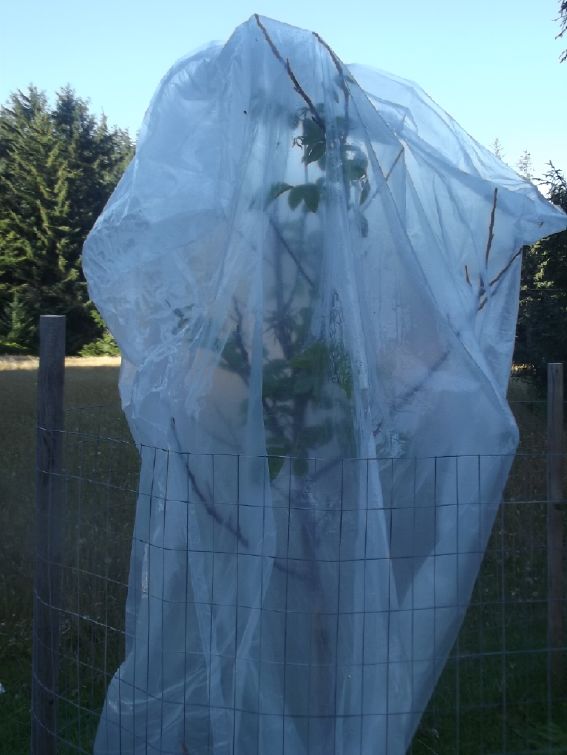
In August the Carpathian tree finally grew some leaves and
started to
look alive again.
Still lots of bare branches.
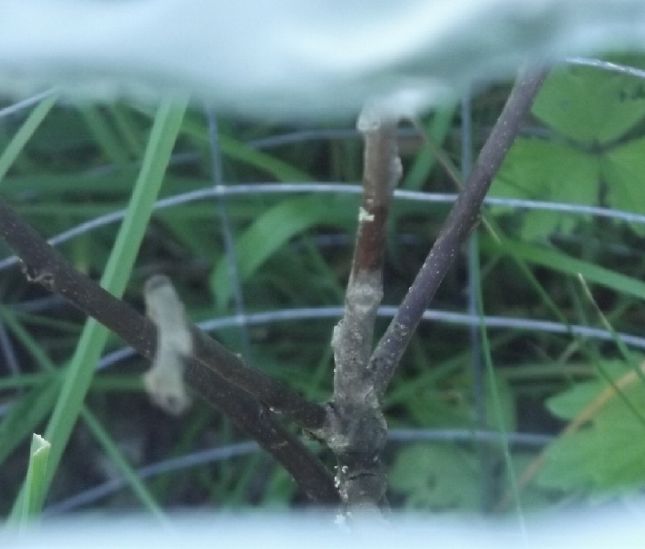
The only thing the Black walnut seemed to grow was lichens.
I'm still hoping that if I keep it watered - and covered next
spring -
it'll come back next year.
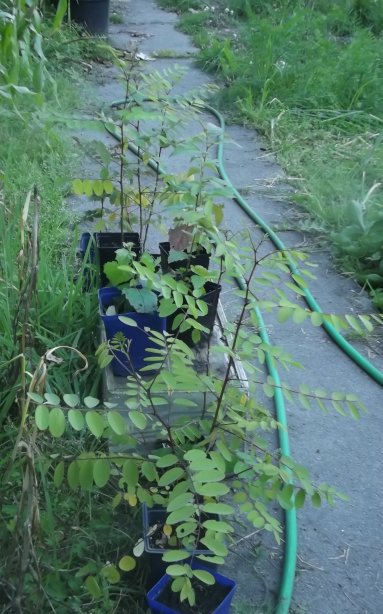
The black locust and birch seeds I planted in April were growing
well - the
locusts were about two feet tall; the birches (hmm... hardly
seen from
this angle)
were growing well with dense leaves.
With the locusts, each long "branch" with leaves is considered
to be
one leaf.
Hard, dense Locust wood used outdoors is said to last longer
than
treated wood.
(Wood is definitely a long term investment starting from seeds!)
In the spring I plan to plant them in a row by the front fence
with
some wire
semicircles to keep the deer off. Then if I can remember to
water
them...
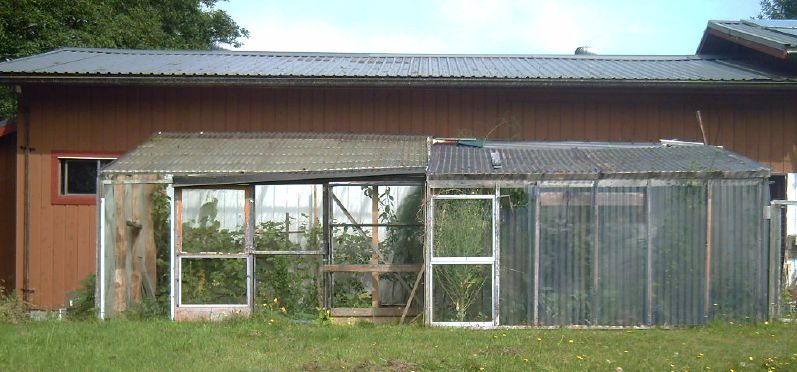
The greenhouse jungle, reclaimed from grass this spring.
With a row of big trees to the West, the left half especially
doesn't get a lot of sun later in the afternoon.
(I'd cut a few of them down, but there's some leaning that would
fall on the shop. Hmm... Maybe I should hire someone to fell
those?
It'd be a lot safer if there's ever a forest fire.)
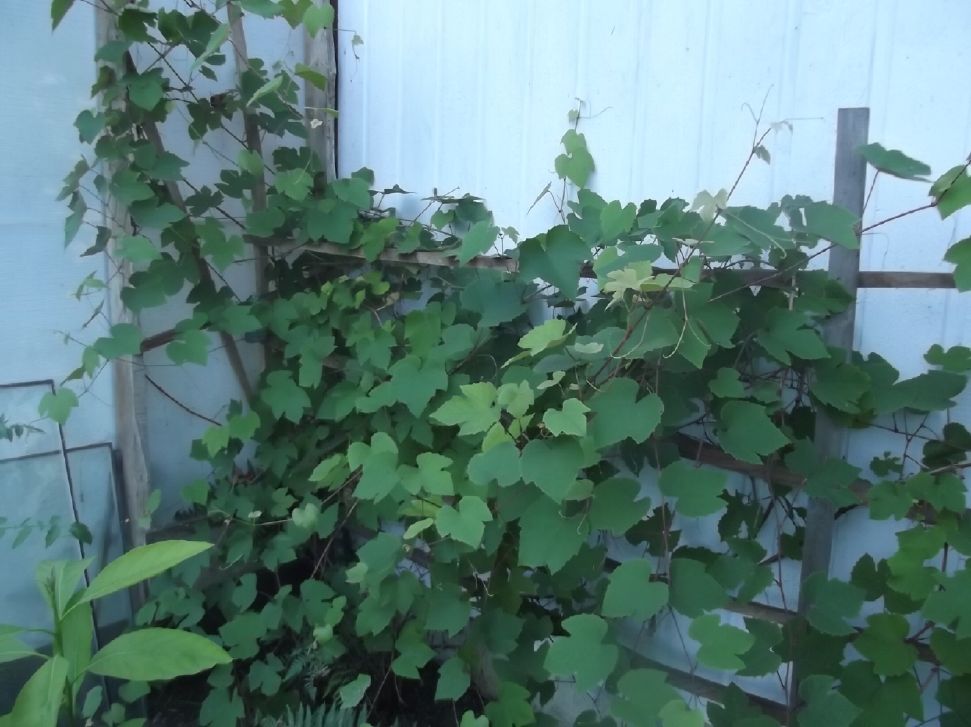
At the back wall of that half is the "Sauvignon" green grape
vine I
bought 3(?) years ago.
The leaves and vines are growing great. Last year there was one
little
cluster of purple(!) grapes.
This year, no flowers!

In the front of that half, tomatos, squash plus a cucumber, the
avocado
shooting up (far right, pot),
the strawberry tree/bush shooting up (tallest thing on left),
jalapeno
"semi hot" pepper (front
left pot), and some "cherry hot peppers" planted very late in
pots.
I
grew the "cherry (semi) hot peppers" in 2019. I liked them and
saved
seeds. They haven't been in the stores since. I've been trying
to grow
them ever since, but they never seemed to germinate and
survive. I
finally ran out of seeds. This year someone mentioned that
peppers need
warmth to germinate. I bet my house windows were too cold in
April or
May! In (?)late July, rummaging through my seed drawer in the
fridge, I
found another small package of the seeds. (Good thing they
were
labelled. I'd never have guessed they were the peppers I've
been
wanting!) This time even if the house generally wasn't warm
enough, I
put them right under an LED light and they grew!
 Coffee tree recovering from its July
sunburn
when I moved it from inside
Coffee tree recovering from its July
sunburn
when I moved it from inside
on the first sunny day in July (15th?)
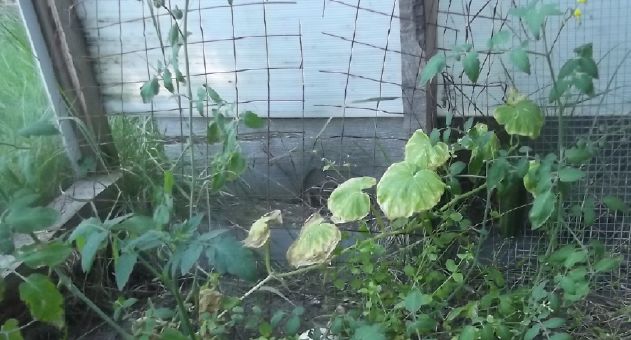
Cucumber: I looked it up on line. New leaves with yellow edges
that
then turn brown mean
potassium deficiency. Looks like a classic case! I then noticed
a
number of my other plants with
similar pattern. And here I had a pail of woodstove ashes just
sitting
doing nothing! I
sprinkled them here, there and everywhere. The squashes and I
think the
fruit trees needed it.

The corn I planted in the greenhouse didn't amount to much. The
corn I
got from Dragonfly garden,
which had been off to a good start, wasn't as far along as that
from my
"corn box", now outside.
I don't think I'll try to grow corn in the greenhouse again.
It's a
waste of time.

The corn outside was just about ripe by the end of August.
It was delicious not long into September.
I wish I had planted some of the "Dragonfly" corn in the box to
compare.
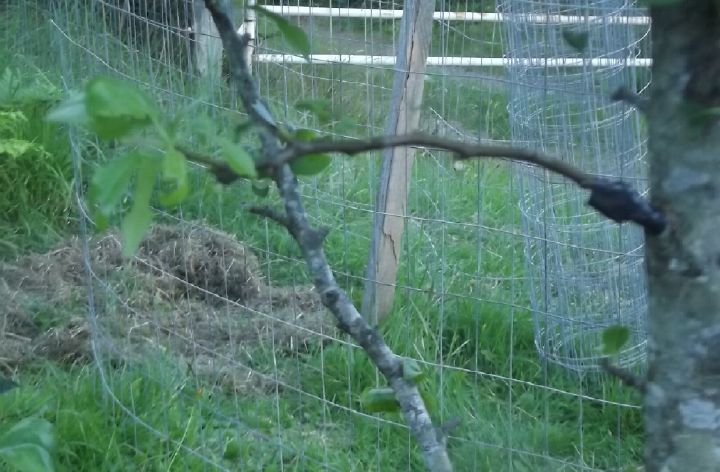
Good news! The graft I put on the Empire apple tree from a tree
I liked
in
town grew new leaves on the end after the deer had eaten most of
them.
I'm hoping for better pollination when it flowers - and maybe
some
nicer apples.
(It's the only successful graft I've ever made. Some gardener I
am!)

First corn and carrot at the end of August.
The corn was riper by the first week of September and the
carrots got
better - Passable results.
I harvested the rest of the corn and the first little plots of
carrots
on September 10th.
The next day it rained.
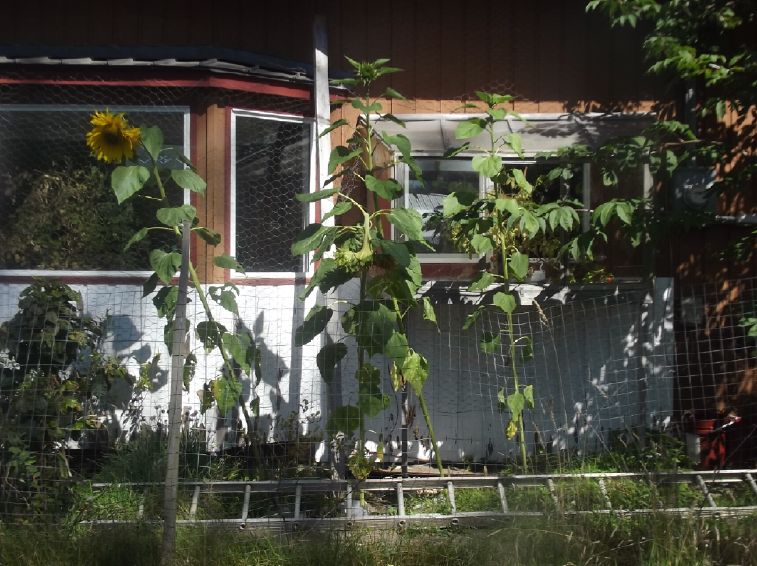
I fear two or three of four sunflowers aren't ripe and probably
won't
get there.
Usually this variety is ready by the end of August. They sure
grew tall!
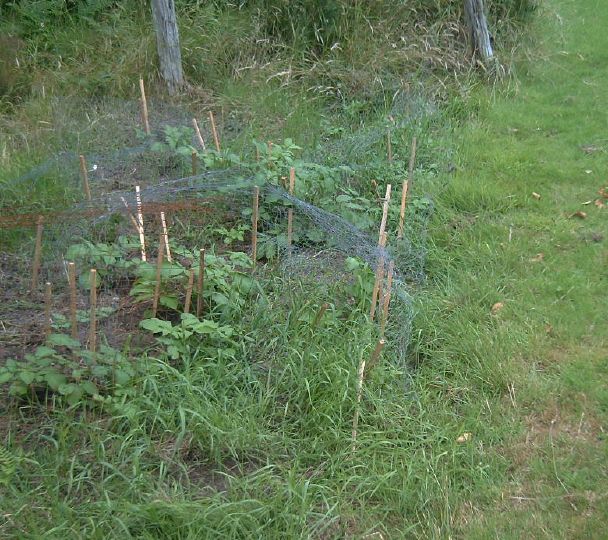
Growing potatos in an open space. The deer eat the "poisonous"
tops
anyway.
The chickens were digging up many of the potatos.
This time I threw some chicken wire and some stucco wire over
top.
It was partly successful. The heavier wire worked better than
the
chicken wire,
which got trampled down or pushed aside.
The garlic was very good
and the onions usable. The strawberries, black currents and josta
berries did well, along with the native salal berries, which like
cool,
damp weather. The raspberries would have been better if I had been
picking them befre the early ones went mouldy. I still got quite a
few.
Looks like I'll only
get a kilogram or so of peas from two rows instead of from each
row.
The squashes started too late to grow fruit except for the
cucumber
someone gave me and a zucchini in the greenhouse. Even those were
marginal. A mouse ate half of the best cucumber (of two). Even the
potatos aren't amounting to much. Great heaps of chickweed drowned
out
my potatos, beets, turnips and carrots I planted in the main
garden,
and threatened even the peas and the garlic.
One looks at
this year's disappointments and hopes for better next year. But
unless
it's a good summer, it's not an ideal place for growing the food
crops
that seem to work so well in other places. Good summer or not,
weeds
grow profusely all year. There's no really cold winter weather to
cut
them down, so by spring planting time they're already a major
headache.
I've been thinking again of the CNC gardening
machine idea, and then I ran across a video on sterilizing soil
with
steam. A CNC gardening machine tilling and steaming out the weed
seeds
in the spring - and then regularly watering each plant - could be
a
wonderful thing! Maybe even something of a game changer? It's a
project
I just haven't managed to get to. But maybe I should as it would
cut
down my gardening time a lot, freeing up more project time!
Plastic Recycling 2.0 (to Make the
Motor
Housing)

~80 pounds of weight on the plastic to squash it down better

In spite of all the weight it wasn't totally flowed to all
points and
solid, but it was better than previously.
I think I can cut a solid piece the size for the motor end plate
from
this slab.
I did this at the start of August, then got the ideas
for
testing things out on the old motor first, so refurbishing the
older
Electric Caik motor took priority.
New Grid-Tied
Solar Power System
[15th] BC Hydro approved my
application. Now the electrician, Adam, is looking into the
paperwork/inspections, parts et al.
[22nd] Adam, who had had other commitments and then the flu, came
over
and we connected the solar panels (actually the microinverters)
from
the roof, through the outdoor shutoff box, to the indoor breaker
panel.
however, we can't flip the switches on until it's inspected, which
it
can't be until the plastic labels arrive for the boxes. Adam has
ordered them and hopefully they'll arrive next week. The Chinese
plug-in grid ties were a whole lot simpler, and easier to access!
And
these "approveable" AP Systems ones are made in China too. and
installed outside - are they going to be any more reliable?
These 10 grid tie microinverters, each powered by two
solar panels, each have a strong WiFi to ensure there is plenty of
perpetual electrosmog around. If it wasn't for the fact that they
are
right above a grounded metal roof and I hope to spend much of my
time
in the Faraday cabin way across the yard anyway, I'd be very
concerned.
No doubt they're powered by the solar panels even when the AC
isn't
connected, so doubtless they've been "live" ever since panel
installation.
Furthermore, although a "communication unit" with
ethernet
was supplied, I discover it won't connect to a web browser.
Instead one
needs a smart phone or tablet to set it up, which also involves
downloading an "app" from Google, and getting an account with AP
Systems. With no cell phone service at my house (ever since they
changed some antennas and put in "5G") I don't have a cell phone,
I'm
not buying another tablet after the last one died ignominiously
and I
have no other use for one, I don't want to go to google plays
store,
and I don't want an account at AP Systems. (Hmm... that must be
how
"the Chinese" (or AP Systems) can shut off YOUR solar panels
remotely,
as I've been hearing about lately. Not some mechanism in the
panels
themselves, but they could probably shut off the inverters over
the
internet.) So I'm going to decline to connect the monitor. Their
whole
monitoring system then is useless - just a way for them to spy on
and
have control over everyone. How then to see what's happening?
Other
than seeing lower electric bills, I guess I'll have to find some
240
volt power monitor that I wire into the circuit breaker box and
put on
the wall next to it. Again the plug-in grid ties that I could just
plug
in through a plugged-in power monitor, were just too simple.
[23rd] I looked on line and found a "DIN Rail Power Monitor". Say!
There was something that could be hooked up within the system
configuration without too many contortions. The outdoor shutoff
box had
DIN rail circuit breakers, with a spare DIN rail slot for the
monitor.
It would be a simple wire-up.
Not without drawbacks... The box was screwed shut and
would have to be opened every time for readings - like daily as
I've
been doing. That screw was going to get lost fast! Then inside,
there
was a plastic cover for breakers over the din rail positions. That
was
going to have to be chopped to put the monitor in and be able to
read
its display. And it was outside. I'd rather have the monitor
indoors.
Another thing I note is that the outdoor switch box,
where
mounted, is going to get rained on. I'll have to make a little
roof over it - and while I'm at it, over the patio door,
which
has needed a roof all along. It's annoying to be rained on while
opening the door to get in!
My (Old) Solar Power System(s)
(My solar panels recent images - TE News #200)
The Usual Daily/Monthly/Yearly
Log
of Solar Power Generated [and grid power consumed]
Notes:
* All times are in PST: clock ~48 minutes ahead of local
sun
time, never PDT which is an hour and 48 minutes ahead.
* Unapproved AC/Grid Tied systems have been removed.
* House panels include four old ones on the roof (upper - total
rating
~ 1000W), two 305W on the roof, three 305W on the south wall below
the
roof, and one broken panel mounted verticly on the porch railing
(seems
to still work but a lot of shade there).
* Cabin DC includes the three carport panels and the two on a pole
in
the yard as well as the four on the cabin roof itself. All nine
are
305W.
* The wall, pole and porch panels are easily wiped off from the
ground
if it snows.
* Km = Nissan Leaf electric car drove distance, then car was
charged.
Car KWH does not add to or subtract from any other readings.
Recent fotos of solar panels, TE News #200:
House System Panels: House roof, wall (9 solar panels) -
Porch
(1 broken one - usually shady)
Cabin System Panels: Carport (3 - sunniest place on the
whole
property) - Pole (2 - shadiest place) -Faraday Cabin (4 - badly
shaded
in winter)
New Order of Daily Solar Readings (Beginning November 2024):
Date HouseDC, CabinDC => Total KWH Solar [Notable power Uses
(EV);
Grid power meter@time] Sky/weather, notes...
July
31st 695.66, 569.45 => 5.56 [10Km; 30805@23:30]
Finished
charging car. (Cloudy,rain - House battery still not up.)
August
1st 703.69, 574.08 => 12.66 [90Km; 30833@'24:30']
Started
recharging car (from 34% left) on solar
2nd 710.38, 575.12 => 7.73 [45Km; 30854@21:00]
Contd.
chj. car to 72% then switched to grid charger. (Then drove again)
3rd 712.92, 577.46 => 4.90 [45+45Km;
30874@21:00]
4th 717.25, 578.47 => 5.34 [30891@23:00]
5th 719.37, 579.82 => 4.80 [30912@20:00]
6th 722.93, 582.50 => 6.42 [55Km; 30931@21:00]
Charged
car on solar by 7.5 KWH, finished from grid. (4 KWH?)
7th 728.64, 583.32 => 6.53 [30960@22:00]
8th 730.56, 585.96 => 4.56 [30983@23:30]
9th 733.20, 588.56 => 5.24 [55Km;
31023@19:30; 50
Km]
10th 735.32, 589.96 => 3.52 [31037@'24:00']
11th 737.36, 590.25 => 2.33 [31046@'24:30']
12th 738.66, 591.26 => 2.31 [35Km(s*); 31053@22:00] *
s=recharged via solar off grid power (~6.9KWH).
13th 747.06, 593.71 => 10.85 [85Km(s*); 31070@'24:00'] *35-63%
(6.0KWH) chj. on solar, rest from power grid. Sunny!
14th 748.40, 694.48 => 2.11 [55Km; 31088@20:00]
Yikes,
winter is here! No solar, chj.car from grid.
15th 750.44, 594.81 => 2.37 [85Km; 31134@22:00] House
barely
recharged from 13th!
16th 753.08, 597.28 => 5.11 [105Km; 31184@'24:00']
17th 756.14, 599.29 => 5.07 [35Km; 31206@23:30]
18th 758.19, 600.47 => 3.23 [31232@'24:00'] AM:
Pouring
rain, cold. Few days 'like summer' so far and it's 5/6 over! I
would be
using substantially more solar power now if there WAS more solar
power!
19th 762.41, 601.55 => 5.30 [31273@22:00] Sun
showed
briefly in AM, but soon it was overcast and then raining again.
20th 768.29, 605.87 => 10.20 [60Km; 31299@23:00] Sun!?! Chj.car
on
solar @55%: 11+KWH !
21st 774.58, 609.46 => 9.88 [31309@'24:00']
22d 776.33, 610.68 => 2.97 [31320@'24:00']
New
solar system finally wired up!
23rd 779.08, 614.89 => 4.38 [55Km; 31338@?; 50Km]
24th 786.46, 616.60 => 9.15 [45Km; 31348@23:00]
Chj.car
solar @63%: 9 KWH
25th 793.09, 616.92 => 6.63 [31357@23:30] STILL
sunny
out! (seems like a miracle!)
26th 793.51, 617.56 => 1.06 [31366@23:30]
27th 800.23, 619.17 => 8.33 [55Km; 31375@19:00]
Chj.car
solar @60%: 9.75 KWH. STILL sunny!
28th 804.84, 621.59 => 7.03 [31386@20:00]
29th 805.25, 622.02 => .82
[31397@'24:30']
Ordered 75m spool of #10-2 cable at Masset Home Hardware to
replace
skinny(er) cables for solar stuff. Over 500$! (and that was
doubtless
the cheapest place) These days, that's the price of two more 350W
solar
panels!
30th 805.67, 622.26 => .66 [55Km; 31412@20:00;
55Km]
31st 814.22, 622.58 => 8.87 [35Km; 31421@20:30]
Solar
chj. 60%=>80%, drove, 55%=>81%, ~12.5 KWH total (just 9 KWH
from
grid)
September
1st 822.71, 624.61 => [31433@'24:00']
2d 824.38, 627.08 => [31441@22:30]
3d 826.77, 629.39 => [50Km; 31447@22:00] chj.car solar
64%=> 80%. No sun, insufficient solar!
4th 828.88, 630.70 => 2.52 [31467@20:00] Chj. rest
of
way (~10 KWH total? still no sun)
5th 837.54, 634.23 => 12.19 [90Km; 31474@19:00]
6th 843.61, 637.51 => 9.35 [55Km; 31502@22:00;
50Km] Had
to charge from grid after 1st drive.
7th 851.40, 640.39 => 10.67 [45Km; 31510@21:30] Charged
58%=>84%
from 2nd drive yesterday, another part charge from 51%=>76%
from
today's drive.
8th 857.55, 643.10 => 8.86 [31525@21:00] Finished
charging. total ~12 KWH.
9th 861.38, 645.90 => [31536@23:00] Still mostly sunny all this
time!
10th 864.26, 646.40 => [31542@23:30] Cloudy.
11th 865.02, 646.69 => [31564@23:00] RAIN! (There goes summer!)
Also, Nissan Leaf said "T/M Error - visit your dealer", and
wouldn't
run. First real trouble with it, but it's very real when it won't
go
anywhere. I had to drive to town and renew the insurance on the
Toyota
Echo, which I had hoped to save a month or two or three of
insurance on.
Chart of daily KWH from solar panels. (Compare August 2025 with July 2025 &
August
2024.)
Days of
__ KWH
|
August 2025
(18 Collectors,
DC/ Batteries.)
|
July 2025
(18 C's - DC/
batteries only)
|
August 2024
(18 C's - Grid
Ties & DC)
|
0.xx
|
2
|
2
|
|
1.xx
|
1
|
|
|
2.xx
|
5
|
2
|
|
3.xx
|
2
|
2
|
1
|
4.xx
|
4
|
|
|
5.xx
|
5
|
3
|
|
6.xx
|
3
|
5
|
2
|
7.xx
|
2
|
2
|
1
|
8.xx
|
2
|
3
|
|
9.xx
|
2
|
4
|
|
10.xx
|
2
|
3
|
2
|
11.xx
|
|
|
3
|
12.xx
|
1
|
2
|
1
|
13.xx
|
|
|
1
|
14.xx
|
|
1
|
1
|
15.xx
|
|
2
|
2
|
16.xx
|
|
|
1
|
17.xx
|
|
|
1
|
18.xx
|
|
|
1
|
19.xx
|
|
|
1
|
20.xx
|
|
|
3
|
21.xx
|
|
|
1
|
22.xx
|
|
|
1
|
23.xx
|
|
|
2
|
24.xx
|
|
|
3
|
25.xx
|
|
|
3
|
Total KWH
for month
|
167.06
|
243.26
|
524.56 |
Km Driven
on Electricity
|
1193.2
@8.2 Km/KWH
=150 KWH (much of
it from off-grid solar)
|
1035.8
@8.2 Km/KWH
= 130 KWH
|
1420.2 Km
180 KWH |
Things Noted - August 2025
* Since the power has nowhere to go except to charge the
batteries, and
with little demand for power from the DC systems, little power was
generated even tho the sun & solar panels had plenty to
give.
(This note is from very early in the month. I still had hopes that
it
would be nice out.)
* This is the most dismal summer I've seen here. (until Aug 21st,
then
it got warm, sunny)
* Owing to "ultrasonic smog" I kept the solar charge controller in
the
cabin Off when I was in it - and then sometimes neglected to turn
it On
when I left during the day.
* With the systems now off-grid and wasting excess power instead
of
sending it to the grid, consumption form the grid was up, from a
low
358 KWH in Aug. 2024 to 616 KWH this year.
Monthly Summaries: Solar Generated KWH [& Power
used
from grid KWH]
As these tables are getting long, I'm not repeating the log of
monthly
reports. The reports for the SIX full years (March 2019 to
February
2025) may be found in TE
News
#201, February 2025. Note that in November 2024 I had to
disconnect
the "unapproved" solar power systems from the power grid, and I
have
been running them as two "off grid" 300 amp-hour, 36 volt, battery
systems since.
2024
Month: HouseAC + DC +Carport+Cabin[+DC] (from Aug 2024)
Jan KWH: 31.37 + 3.14 + 16.85 + 16.82 = 68.18
[grid
power used: 909; car (very rough estimates): 160*]
Feb KWH: 96.52 + 2.36 + 49.67 + 52.98 = 201.53 [grid: 791;
car:
130]
FIVE full Years of solar!
Mar KWH 150.09+ 1.63 + 93.59 + 92.50 = 337.81
[grid:
717; car: 140]
Apr KWH 181.89+35.55 +123.50+142.74 = 483.68
[grid: 575; car: 140]
May KWH 129.23+67.38 +109.6 +126.32 = 432.53
[grid: 405; car: 145]
Jun KWH 152.54+51.02+118.99+141.17 = 463.72
[grid: 420; car: 190]
July KWH 174.22+30.53+111.19+128.62 = 444.56
[grid: 386; car: 165]
Aug KWH 221.99+ 2.63 +142.49+151.67+ 5.78 = 524.56 [grid:
358;
car: 180]
SeptKWH 120.98+ 2.49 + 83.50 + 19.10+ 39.95 = 266.02 [grid: 662
(yowr!); car: 155*]
Oct KWH 78.48+ 7.29 + 64.39 + 7.52 + 40.75 =
198.43
[grid: 711; car: 120*]
Nov KWH 19.63+12.19+ 23.90 + 3.35 + 25.62
=
84.69 [grid: 900 (ACK!);car: 110*]
Now solar is charging
batteries only. 2 DC systems: house, cabin.
Dec KWH 20.37 + 16.76 = 37.13 [grid: 1866 (using electric
heat -
awg!); car: 120*]
2025
Jan KWH 35.02 + 26.30 = 61.32 [grid: 2136 (electric
heat
OW!); car: 120*]
Feb KWH 55.43 + 39.00 = 94.43 [grid: 1937; car: 100*]
SIX full Years of
solar!
Mar KWH 115.13 + 87.41 = 202.54
[grid:
1860; car: 155* KWH]
Apr KWH 126.25 + 120.36 = 246.61 [grid: 1246; car: 100*]
May KWH 147.08 + 186.24 = 333.32 [grid: 1354; car: 150*]
Jun 145.58 + 170.97 = 316.55 [grid: 959; car: 130*]
July 156.48+ 86.78 = 243.26 [grid: 653; car 130]
August 118.56 + 48.50 = 167.06 [grid: 616; car 150]
* Car consumption comes from solar and or
grid: it
does not add to other figures. (Just from grid from Nov. 18th.
2024 on)
Annual Totals
1. March 2019-Feb. 2020: 2196.15 KWH Solar [used 7927
KWH
from grid; EV use: -] 10, 11, 12 solar panels
2. March 2020-Feb. 2021: 2069.82 KWH Solar [used 11294 KWH from
grid;
EV use: - (More electric heat - BR, Trailer & Perry's RV)] 12
solar
panels
3. March 2021-Feb. 2022: 2063.05 KWH Solar [used 10977 KWH from
grid;
EV use ~~1485 KWH] 12 solar panels, 14 near end of year.
4a. March 2022-August 2022: in (the best) 6 months, about 2725 KWH
solar - more than in any previous entire year!
4. March2022-Feb. 2023: 3793.37 KWH Solar [used 12038 KWH from
grid; EV
use: ~1583 KWH] 14, 15, 18 solar panels
5. March 2023-Feb. 2024: 3891.35 KWH Solar [used 7914 KWH from
power
grid; EV use: ~1515 KWH] 18 solar panels
6. March 2024-Feb. 2025: 3428.88 KWH Solar [used 12773 KWH from
grid;
EV used: ~1685 KWH]
Money Saved or Earned - @ 12¢ [All BC residential elec.
rate] ;
@ 50¢ [2018 cost of diesel fuel to BC Hydro] ; @ 1$ per KWH
[actual
total cost to BC Hydro in 2022 according to an employee]; or maybe
it's
62 ¢/KWH [according to BC Hydro at Renewable Energy Symposium
Sept.
2024]:
1. 263.42$ ; 1097.58$ ; 2196.15$
2. 248.38$ ; 1034.91$ ; 2069.82$
3. 247.57$ ; 1031.53$ ; 2063.05$
4. 455.20$ ; 1896.69$ ; 3793.37$
5. 466.96$ ; 1945.68$ ; 3891.35$
6. 411.47$ ; 1714.44$ ; 3428.88$
I had to disconnect the system from the grid in
November
2024. These two now independent installations (house, cabin) will
continue to run their 36 volt DC systems and I'll see how I can
most
effectively utilize the available solar energy with the limited
available storage.
http://www.TurquoiseEnergy.com
Haida Gwaii, BC Canada






 In
the
magnet
compartment,
the
magnets had at some point (long ago, I think) been rubbing on the
separator wall between rotor and stator. But it is one of the
magic
things about axial flux with supermagnets that where magnetic gaps
in
radial flux motors are measured in fractions of a millimeter, they
are
somewhere around 12 mmin mine and others, a distance that prevents
the
coils from gradually demagnetizing the rare earth magnets, and it
even
allows a protective wall between rotor and stator.
In
the
magnet
compartment,
the
magnets had at some point (long ago, I think) been rubbing on the
separator wall between rotor and stator. But it is one of the
magic
things about axial flux with supermagnets that where magnetic gaps
in
radial flux motors are measured in fractions of a millimeter, they
are
somewhere around 12 mmin mine and others, a distance that prevents
the
coils from gradually demagnetizing the rare earth magnets, and it
even
allows a protective wall between rotor and stator. In
the
stator,
some
of the
ilmenite in "Plastidip" had flaked off, and the three wires coming
out
a single slot were fraying, threatening to short out the motor
like the
one on the Sprint had done in 2016. And I had the thought that
perhaps
some on the interconnections inside might be in danger of
vibrating
together and shorting too.
In
the
stator,
some
of the
ilmenite in "Plastidip" had flaked off, and the three wires coming
out
a single slot were fraying, threatening to short out the motor
like the
one on the Sprint had done in 2016. And I had the thought that
perhaps
some on the interconnections inside might be in danger of
vibrating
together and shorting too. Having
recently got the idea to simply
add ilmenite to epoxy, I coated at least the tops and down the
outsides
of the coils, and along some of the wires, with it. (I suppose I
could
have pulled the coils out and done all faces. I didn't.)
Having
recently got the idea to simply
add ilmenite to epoxy, I coated at least the tops and down the
outsides
of the coils, and along some of the wires, with it. (I suppose I
could
have pulled the coils out and done all faces. I didn't.)
 It
has
finally
occurred
to
me to look up a chlorine pourbaix diagram, since I was
using potassium chloride as the electrolyte. Sure enough -- it's a
bit
over +1 volt to oxidize Cl- to ClO- at pH 12). +1 -
-1.5 =
2.5 V. That would explain it! With the K+ that would be potassium
hypochlorite, a form of Bleach for my electrolyte! But it's still
dissolved. (Did I smell any chlorine gas? Would I remember?) There
wouldn't be much of it in contact with the electrode to maintain
that
voltage, so it dropped quickly to 2.3 when I tried a discharge
test.
And surely unless the cell was well sealed, which most of them
weren't,
bleach will pick up O2 from the air and self-discharge. As well as
discharge when ClO- wanders over to the negative 'trode.
'Overnight'
seems a reasonable time frame for the self discharge. And
oxidizing
chlorides probably explains the gradual accumulation of green
colored
gunk on the [graphite] positive terminal on the outside of the
cell -
nickel chloride.
It
has
finally
occurred
to
me to look up a chlorine pourbaix diagram, since I was
using potassium chloride as the electrolyte. Sure enough -- it's a
bit
over +1 volt to oxidize Cl- to ClO- at pH 12). +1 -
-1.5 =
2.5 V. That would explain it! With the K+ that would be potassium
hypochlorite, a form of Bleach for my electrolyte! But it's still
dissolved. (Did I smell any chlorine gas? Would I remember?) There
wouldn't be much of it in contact with the electrode to maintain
that
voltage, so it dropped quickly to 2.3 when I tried a discharge
test.
And surely unless the cell was well sealed, which most of them
weren't,
bleach will pick up O2 from the air and self-discharge. As well as
discharge when ClO- wanders over to the negative 'trode.
'Overnight'
seems a reasonable time frame for the self discharge. And
oxidizing
chlorides probably explains the gradual accumulation of green
colored
gunk on the [graphite] positive terminal on the outside of the
cell -
nickel chloride.

 [22nd]
The
electrician, Adam, finally came and we connected the solar
inverters to the circuit breaker panel via the BC Hydro required
outdoor shutoff box. All the wiring in metal conduit. The worst
'renovation' thing was removing a small section of wallboard for
the
conduit connection. Luckily the breaker panel, tho on an inside
wall,
wasn't far in from the outside wall, and the wall space, despite
its
proximity to the breaker box, wasn't already full of wiring. (one
doorbell wire.) [28th] Adam brought the "lamacoid" labels and
pasted
them on, and he added a copper ground wire apparently required by
code
inside the grounded metal pipe.
[22nd]
The
electrician, Adam, finally came and we connected the solar
inverters to the circuit breaker panel via the BC Hydro required
outdoor shutoff box. All the wiring in metal conduit. The worst
'renovation' thing was removing a small section of wallboard for
the
conduit connection. Luckily the breaker panel, tho on an inside
wall,
wasn't far in from the outside wall, and the wall space, despite
its
proximity to the breaker box, wasn't already full of wiring. (one
doorbell wire.) [28th] Adam brought the "lamacoid" labels and
pasted
them on, and he added a copper ground wire apparently required by
code
inside the grounded metal pipe. [31st]
I
cut
two
five
foot
long bars and sharpened one end. I drilled and
threaded the other end for a 5/16 inch bolt to attach the wire. I
started in the middle of the long walls, disconnecting the wires
and
pulling up the copper pipes. The bars didn't fold up when I
pounded
them to over 4 feet deep - much better! Later I cut two more for
the
corner grounds of the cabin later.
[31st]
I
cut
two
five
foot
long bars and sharpened one end. I drilled and
threaded the other end for a 5/16 inch bolt to attach the wire. I
started in the middle of the long walls, disconnecting the wires
and
pulling up the copper pipes. The bars didn't fold up when I
pounded
them to over 4 feet deep - much better! Later I cut two more for
the
corner grounds of the cabin later.
 [9th]
I
re-melted
the
HDPE
slab in the
plastic oven at 186 degrees instead of 180, with ~80 pounds of
weights
instead of 40 on top of the mold. It still didn't flow well, and
it was
almost an inch thick in one corner and just 5/8 in the opposite
one.
But it looked like I could cut out a solid piece big enough for
the
motor end plate. I would have to route it flat as well as route
out the
required contours to mount the coils.
[9th]
I
re-melted
the
HDPE
slab in the
plastic oven at 186 degrees instead of 180, with ~80 pounds of
weights
instead of 40 on top of the mold. It still didn't flow well, and
it was
almost an inch thick in one corner and just 5/8 in the opposite
one.
But it looked like I could cut out a solid piece big enough for
the
motor end plate. I would have to route it flat as well as route
out the
required contours to mount the coils. [15th] I looked at the motor to
see where I might add in a small cooling fan. Wait! How on Earth
are
the spinning magnets, acting as a centrifugal fan, supposed to
flow
cooling air through those tiny little air outlet holes? No wonder
it
doesn't cool well! Before going to the trouble of putting in a
cooling
fan, I think I should just try making the holes bigger and more
numerous. So the jobs on the motor are to drill holes and to bring
the
coil common centers out through a wire. Not so much to do! The set
screw on the bearing tightener wouldn't come out so I sprayed some
WD40
on all the rusty looking parts.
[15th] I looked at the motor to
see where I might add in a small cooling fan. Wait! How on Earth
are
the spinning magnets, acting as a centrifugal fan, supposed to
flow
cooling air through those tiny little air outlet holes? No wonder
it
doesn't cool well! Before going to the trouble of putting in a
cooling
fan, I think I should just try making the holes bigger and more
numerous. So the jobs on the motor are to drill holes and to bring
the
coil common centers out through a wire. Not so much to do! The set
screw on the bearing tightener wouldn't come out so I sprayed some
WD40
on all the rusty looking parts. [18th]
Sure
enough
-
the
sleeving has frayed
off. How long would it have run before the thin enamel rubbed
through
and shorted?
[18th]
Sure
enough
-
the
sleeving has frayed
off. How long would it have run before the thin enamel rubbed
through
and shorted? One day in here I drilled the
ventilation holes bigger in the rotor end cover plate.
One day in here I drilled the
ventilation holes bigger in the rotor end cover plate. [22nd] I removed the hall
sensors board as it looked corroded, and anyway I didn't want to
paint
it in when I touched up the coils & connecting wires. I
decided I
should make a 3 LED "breakout" board for between the motor
controller
and motor, to show which magnet sensors were on and off and
disclose
any sensor faults or wrong patterns as the motor was turned.
[22nd] I removed the hall
sensors board as it looked corroded, and anyway I didn't want to
paint
it in when I touched up the coils & connecting wires. I
decided I
should make a 3 LED "breakout" board for between the motor
controller
and motor, to show which magnet sensors were on and off and
disclose
any sensor faults or wrong patterns as the motor was turned. [25th]
I
mixed
28
g
of epoxy with ilmenite
and painted around the inside of the motor, going over the
windings of the coils (for the ilmenite - some had flaked off) and
their connecting wires (to stiffen them so they wouldn't vibrate
and
rub and eventually short out).
[25th]
I
mixed
28
g
of epoxy with ilmenite
and painted around the inside of the motor, going over the
windings of the coils (for the ilmenite - some had flaked off) and
their connecting wires (to stiffen them so they wouldn't vibrate
and
rub and eventually short out). [12th]
I finally got around to clearing off the "hot wire table saw" to
cut
foam (or is it a "hot wire foam mill"?). I now had the huge chunk
from
the beach which I had thought had a plastic barrel for a center (I
thought I heard water sloshing around inside it), and a smaller
one I
got from the recycling center - Craig phoned me to let me know it
was
there.
[12th]
I finally got around to clearing off the "hot wire table saw" to
cut
foam (or is it a "hot wire foam mill"?). I now had the huge chunk
from
the beach which I had thought had a plastic barrel for a center (I
thought I heard water sloshing around inside it), and a smaller
one I
got from the recycling center - Craig phoned me to let me know it
was
there.















